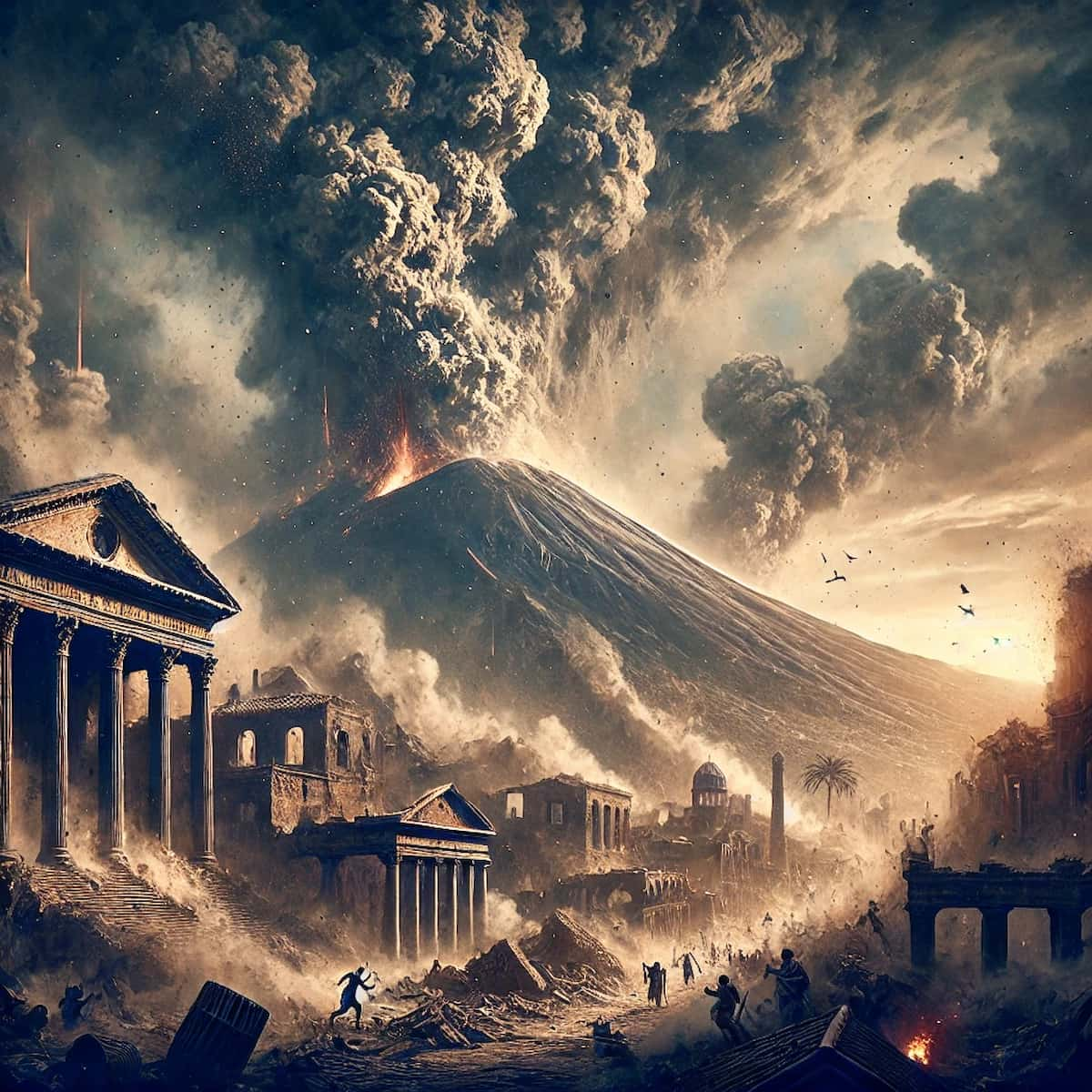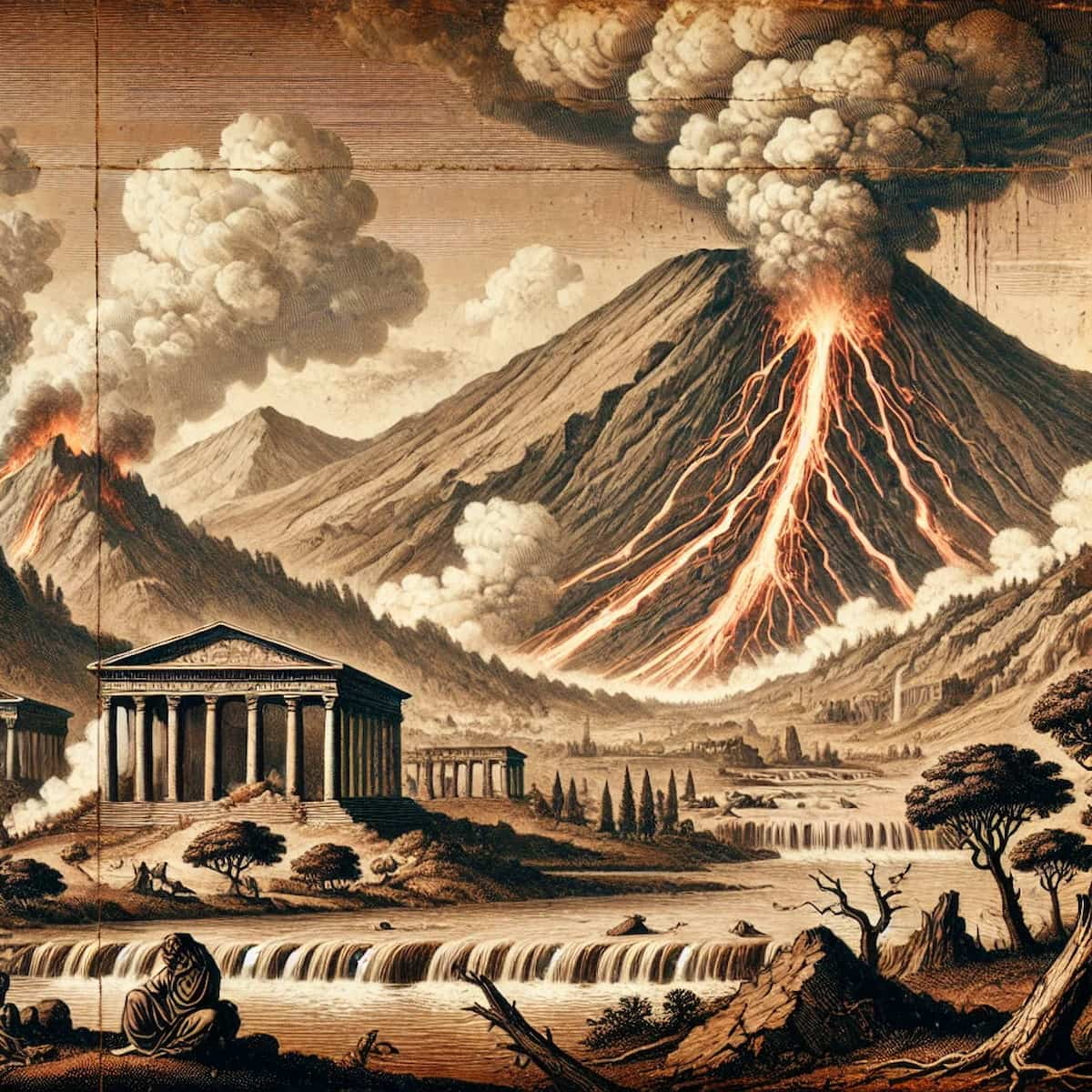
Watch short for this article (5 slides)
Fire Mountains of Myth and Magma: Understanding Volcanoes Through Legend and Science
For millennia, the earth-shattering power and fiery spectacle of volcanic eruptions have profoundly shaped human perception of the natural world. Before the advent of geology and plate tectonics, cultures worldwide sought to explain these terrifying and awe-inspiring events through intricate mythologies. Volcanoes became the dwelling places of powerful gods, the gates to fiery underworlds, or manifestations of divine wrath punishing human transgressions. Today, science provides a rational framework based on crustal dynamics and magma movement, yet the primal fear and fascination evoked by these "fire mountains" persist. Let's journey through the rich tapestry of volcanic myths and contrast them with our modern scientific understanding.

Volcanic eruptions have inspired both fear and mythological explanations throughout history.
Whispers of the Gods: Volcanoes in Mythology
Lacking scientific tools, ancient peoples interpreted the violent and unpredictable nature of volcanic eruptions through a supernatural lens. The ground shaking, the thunderous explosions, the rivers of molten rock, and the choking ash clouds were readily attributed to powerful, often temperamental, deities.
Greco-Roman Forge Gods: Hephaestus and Vulcan
- The Myth: In Greek mythology, Hephaestus (Roman: Vulcan) was the god of fire, metalworking, blacksmithing, and craftsmanship. He was often depicted as lame and resided within volcanoes, most famously Mount Etna in Sicily (for Hephaestus) or the volcanic island of Vulcano (giving us the word "volcano" itself). His subterranean forge was where he crafted thunderbolts for Zeus, armor for heroes, and intricate devices for the gods.
- The Connection: Eruptions – the smoke, the fiery glow, the noise, the ejection of incandescent rocks ("volcanic bombs") – were interpreted as signs of Hephaestus/Vulcan working vigorously at his forge, or perhaps venting his anger. The rumbling sounds preceding an eruption could be heard as the hammering from his divine workshop. The catastrophic eruption of Mount Vesuvius in 79 AD, which buried Pompeii and Herculaneum, was readily seen by many Romans as an expression of divine fury, potentially from Vulcan or other angered gods.
Pele: Hawaii's Volcanic Creator and Destroyer
- The Myth: In Hawaiian indigenous religion, Pele is the potent goddess of volcanoes, fire, lightning, and wind. She is a central figure, known for her passionate, creative, and fiercely destructive nature. Her home is believed to be the Halemaʻumaʻu crater within the caldera of Kīlauea, one of the world's most active volcanoes.
- The Connection: Pele's moods are directly linked to volcanic activity. Lava flows are seen as her physical manifestation, extending her domain. Eruptions occur when she is angered, often by disrespect or rivalry. Specific volcanic phenomena have direct associations: fine threads of volcanic glass are called "Pele's hair," and small droplets of cooled lava are "Pele's tears." Respect for Pele remains deeply ingrained in Hawaiian culture, influencing attitudes towards the islands' volcanic landscapes. (Source: NPS - Hawaii Volcanoes National Park - Pele)
Global Echoes: Volcanoes in Other Cultures
- Japan: Mount Fuji, an active stratovolcano, is considered sacred in Shintoism, associated with the goddess Konohanasakuya-hime. Its serene beauty and potential power inspire deep reverence.
- Iceland: Norse mythology didn't explicitly assign gods to specific volcanoes, but the fiery eruptions and volcanic landscapes contributed to tales of giants, subterranean realms (like Muspelheim, the land of fire), and cosmic battles.
- Mesoamerica: Volcanoes like Popocatépetl in Mexico feature prominently in Aztec mythology, often personified or seen as gateways between worlds.
These myths served a crucial purpose: they provided explanations for terrifying natural events, offered a framework for understanding humanity's place within a powerful natural order, and guided rituals aimed at appeasing the forces believed to control these phenomena.
The Scientific Perspective: Unearthing the Mechanisms of Eruption
Modern geology provides a naturalistic explanation for volcanic activity, rooted in the theory of plate tectonics and the behavior of molten rock beneath Earth's surface.
Plate Tectonics: The Driving Force
Earth's outer shell (the lithosphere) is broken into large, rigid plates that constantly move atop the semi-molten asthenosphere below. Most volcanoes are found at the boundaries where these plates interact:
- Subduction Zones: Where one tectonic plate slides beneath another (e.g., the Pacific Ring of Fire). As the subducting plate descends, water trapped within its minerals is released, lowering the melting point of the overlying mantle wedge, generating magma. This magma rises, often forming chains of explosive stratovolcanoes (like the Andes or the Cascades).
- Divergent Boundaries: Where plates pull apart (e.g., the Mid-Atlantic Ridge, East African Rift). As the plates separate, reduced pressure allows mantle rock to melt (decompression melting), producing basaltic magma that erupts relatively gently to form new crust, often underwater.
- Hotspots: Areas where plumes of exceptionally hot mantle material rise from deep within the Earth, melting the overlying plate regardless of boundary locations. As the tectonic plate moves over the stationary hotspot, a chain of volcanoes can form (e.g., the Hawaiian Islands, Yellowstone).
Magma Generation, Ascent, and Composition
- Magma vs. Lava: Magma is molten rock *beneath* the Earth's surface; lava is molten rock that has erupted *onto* the surface.
- Magma Chambers: Rising magma often accumulates in reservoirs (magma chambers) beneath a volcano. Here, it can cool, crystallize, and change composition (differentiation).
- The Key to Eruption Style (Viscosity & Gas Content): The behavior of an eruption is primarily controlled by the magma's properties:
- Viscosity: Resistance to flow. Magma rich in silica (like andesite or rhyolite, common at subduction zones) is highly viscous (thick, sticky). Magma low in silica (like basalt, common at hotspots and divergent boundaries) is less viscous (runny).
- Gas Content: Magma contains dissolved gases (primarily water vapor, CO₂, SO₂). As magma rises and pressure decreases, these gases come out of solution, forming bubbles (exsolution).
The Eruption Trigger and Process
Eruptions occur when the pressure within the magma chamber overcomes the strength of the overlying rock. This can be triggered by:
- Gas Pressure Buildup: Expanding gas bubbles increase internal pressure dramatically. In viscous magma, bubbles cannot escape easily, leading to pressure build-up and potentially explosive eruptions. In less viscous magma, gas can escape more readily, leading to gentler lava flows.
- Magma Buoyancy: Less dense magma rises relative to surrounding rock.
- New Magma Injection: Fresh, hot magma entering an existing chamber can increase pressure and temperature, triggering an eruption.
Volcano Types and Eruption Styles
- Shield Volcanoes (e.g., Mauna Loa, Hawaii): Formed by eruptions of low-viscosity basaltic lava that flows easily over long distances. Characterized by broad, gentle slopes and generally effusive (non-explosive) eruptions producing lava flows.
- Stratovolcanoes / Composite Volcanoes (e.g., Vesuvius, Mount Fuji, Mount St. Helens): Built from alternating layers of viscous lava flows, ash, and pyroclastic debris. Steep-sided cones. Associated with higher-viscosity, gas-rich magma, leading to potentially highly explosive eruptions (Plinian eruptions) generating massive ash columns, pyroclastic flows (fast-moving avalanches of hot gas and debris), and lahars (volcanic mudflows).
- Cinder Cones: Smaller, steep-sided cones built primarily from ejected fragments (cinders or scoria).
- Calderas: Large depressions formed by the collapse of a volcano into its magma chamber following a massive eruption (e.g., Crater Lake, Yellowstone).
(Source: USGS - Volcanoes Explained)
Vesuvius Revisited: Where Myth and Catastrophe Converged (79 AD)
The eruption of Mount Vesuvius provides a stark example where ancient interpretations collided with geological reality.
- The Event: After centuries of dormancy (regarded simply as a mountain), Vesuvius erupted catastrophically. The eruption progressed through distinct phases, vividly described in letters by Pliny the Younger who witnessed it from across the Bay of Naples. It began with a massive Plinian eruption column, estimated to have reached over 30 kilometers (20 miles) high, raining down pumice and ash primarily on Pompeii. This initial phase allowed some residents time to flee.
- The Lethal Climax: Subsequently, the eruption column collapsed multiple times, generating devastating pyroclastic flows and surges – superheated, fast-moving clouds of gas and volcanic debris. These swept through Herculaneum and later Pompeii, killing remaining inhabitants almost instantly through intense heat (thermal shock) and asphyxiation.
- Preservation: The layers of ash and pumice buried the cities rapidly, preserving buildings, objects, and even the voids left by decomposed bodies (later filled with plaster by archaeologists) in remarkable detail, providing an unparalleled snapshot of Roman life.
- Interpretation: For the Romans, this unprecedented disaster was interpreted through their mythological framework – a terrifying display of divine power and possible punishment, solidifying Vesuvius's association with Vulcan and the volatile forces of the underworld. Scientifically, it stands as a classic example of a deadly explosive eruption from a stratovolcano located in a complex tectonic setting. (Source: World History Encyclopedia - Destruction of Pompeii)

The tragic eruption of Vesuvius preserved moments in time, linking mythic fear with geological reality.
Bridging Perspectives: From Appeasement to Understanding
Myths and scientific explanations, while different in methodology, both stem from the fundamental human need to make sense of powerful, potentially life-threatening natural phenomena. Myths provided meaning, context, and perceived methods of control (appeasement rituals) in the absence of physical understanding. They often encoded generations of observations about precursor signs (changes in animal behavior, ground tremors, gas emissions) that might have served as rudimentary warnings.
Science offers a different kind of power: the power of prediction (though still imperfect), hazard assessment, and mitigation. By understanding plate tectonics, magma dynamics, and eruption precursors (monitoring seismicity, ground deformation, gas emissions), scientists can forecast potential activity, create hazard maps, and inform evacuation plans, fulfilling the same core need for safety and understanding that ancient myths addressed symbolically.
Conclusion: The Enduring Power of Fire Mountains
Volcanoes remain potent symbols of Earth's raw power – simultaneously creators of new land and destroyers of civilizations. The ancient myths, attributing eruptions to the whims of fiery gods like Vulcan, Hephaestus, or Pele, reflect humanity's enduring awe and attempts to rationalize forces beyond comprehension. These narratives provided explanations and a sense of order in a world where the ground could split open and mountains could explode.
Today, science has peeled back the mythological veil, revealing the intricate geological processes driven by plate tectonics and magma dynamics. This understanding doesn't diminish the awe but replaces supernatural fear with rational knowledge, enabling us to better monitor hazards, assess risks, and prepare for future events. Yet, whether viewed through the lens of myth or science, volcanoes compel us to recognize the dynamic, powerful, and sometimes perilous nature of the planet we inhabit.